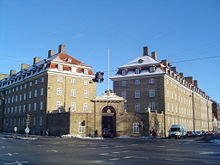Danske Statsbaner
2008/9 Schools Wikipedia Selection. Related subjects: Railway transport
| DSB | |
|---|---|
 |
|
| Type | Government-owned corporation |
| Founded | October 1, 1885 |
| Headquarters | Copenhagen, Denmark |
| Key people | Søren Eriksen, President and CEO (acting) |
| Industry | Rail transport |
| Products | Passenger rail transport |
| Revenue | DKK 10.5 billion (2005) |
| Operating income | DKK 1.3 billion (2005) |
| Net income | DKK 745 million (2005) |
| Employees | 9,078 (2005 average) |
| Website | www.dsb.dk |
DSB, an abbreviation of Danske Statsbaner (Danish State Railways), is the largest Danish train operating company, and the largest in Scandinavia. While DSB is responsible for passenger train operation on most of the Danish railways, goods transport and railway maintenance are outside its scope. DSB runs a commuter rail system, called S-train, in the area around the Danish capital, Copenhagen, that connects the different areas and suburbs in the greater metropolitan area.
DSB was founded in 1885 when the government-owned companies De jysk-fynske Statsbaner and De sjællandske Statsbaner merged.
History
On September 1, 1867, the Danish state took over Det danske Jernbane-Driftsselskab (The Danish Railway Operation Company), the major railway company in Jutland and Funen, and consequently, De jysk-fynske Statsbaner (The State Railways of Jutland and Funen) were formed.
The Danish state took over Det sjællandske Jernbaneselskab (The Railway Company of Zealand) on January 1, 1880, forming De sjællandske Statsbaner (The State Railways of Zealand). With the majority of railways on both sides of the Great Belt thus owned by the Danish state, it was not until October 1, 1885 that the companies of Jutland/Funen and Zealand merged into one national railway company, De danske Statsbaner (The Danish State Railways), the merger being finalised on April 1, 1893.
Coinciding with the opening of the Little Belt Bridge in 1935, DSB introduced their new express train concept known as lyntog ('lightning trains'). These diesel-powered trains featured a then-impressive top speed of 120 km/h as well as a high level of comfort, and they proved themselves DSB's most commercially successful initiative of the 1930s.
World War II left DSB with a fleet of outdated and worn-out trains, and although the use of motorised locomotives and DMUs was slowly starting to prevail during the 1920s and '30s, the diesel trains could not immediately satisfy the needs for pulling power. Thus, it was not until the mid-1950s that diesel locomotives got a real foothold with DSB.
DSB's class MY diesel locomotives, delivered from NOHAB starting in 1954, proved themselves very reliable and economically feasible compared to the steam locomotives, eventually putting the age of steam to an end as well as being a decisive factor in DSB's choice of motive power for nearly three decades.
The 1960s were marked by an increasingly poor economy for DSB, leading to a steady staff reduction throughout the decade. However, this was also accompanied by the appearance of new technology, notably the utilisation of electronic equipment, improving the safety and efficiency of DSB's railway traffic. In 1972, along with the celebration of the 125th anniversary of railways in Denmark, DSB introduced a new, mainly red design (with engine rooms of locomotives painted black), replacing the traditional maroon livery with yellow winged wheel symbols. DSB's position was additionally strengthened by the oil crisis in 1973.
In 1990, after a delay of several years, the IC3 trains came into use, initially as lyntog, and in 1991 as ordinary intercity trains. The IC3 trains, being a specimen of the Flexliner type of multiple units, have a distinct appearance due to the rubber-framed ends, allowing access between separate trainsets when coupled together.
The Great Belt fixed link was opened for railway traffic in 1997 (a year before road traffic), replacing DSB's railway ferries. In 1997, infrastructural duties were branched off into a new agency under the Danish Ministry of Transport, Banestyrelsen (now: Banedanmark), leaving DSB with the task of train operation. A new design was presented in 1998, as well as the announcement of the "Good Trains for All" plan, seeking to replace old and less comfortable trains by 2006/2007. DSB was turned into an independent public corporation on January 1, 1999.
The goods department of DSB, DSB Gods, was merged with Railion in 2001, and DSB now solely manages passenger rail service, including the operation of railway stations.
Corporate structure

DSB is an independent public state-owned corporation under the Danish Ministry of Transport and Energy. This has been the case since 1999, and is the result of a political desire to liberalise the Danish railways. Thus, DSB now operates on a for-profit basis, although it retains certain public service commitments via contracts with the Ministry of Transport and Energy.
As of 2005, DSB employs about 9,000 people. Keld Sengeløv, the former president and CEO, died due to an unknown illness while traveling with friends in Scotland, UK on 3 September 2006. His successor is Søren Eriksen.
Divisions
- DSB Salg (sales and marketing)
- DSB Produktion (operation and maintenance of trains, except S-trains)
- DSB S-tog a/s (operation of the S-train network)
- DSB Detail a/s (management of shops on DSB stations)
- DSB International (train operation abroad)
Services
DSB operates several types of passenger trains, varying in number of stops and motive power. Apart from the S-trains, types available for the general public include:
- Regional trains (RØ in Eastern Denmark, RV in Western Denmark; ØR in the Oresund region)
- Inter-regional trains (IR)
- InterCity trains (IC)
- InterCityLyn (L) (express InterCity trains)
- EuroCity trains (EC)
- EuroNight trains (EN)




